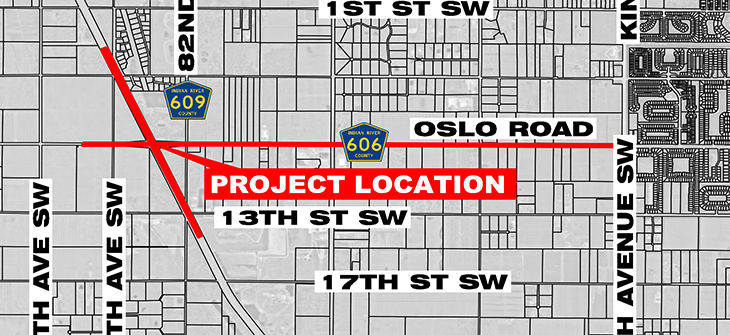Construction on the $45 million Oslo Road interchange on Interstate 95 could start as soon as 2022, if Florida Department of Transportation wins a federal grant for Indian River County’s top ranked road project.
The U.S. Department of Transportation is expected to decide this summer whether to award a Better Utilizing Investments to Leverage Development grant for the Oslo Road interchange project, said Brian Freeman, a county transportation planner.
Obtaining the grant could advance the project’s start date by several years to 2022-2023, Freeman said last week during an online workshop about the county’s Long-Range Transportation Plan for 2045.
“We’re excited because it’s the only project they’re nominating in the entire state,” Freeman said. “If that’s awarded, that could move construction of the interchange up to 2022-2023. That’s actually not that far down the road.”
“If not, we’re probably looking at more like the middle of the decade,” Freeman said.
The Oslo Road interchange has been Indian River County’s No. 1 ranked road project since 2005, records show.
The new interchange would set the stage for the $20 million widening of Oslo Road from 82nd Avenue to 58th Avenue, records show. The road has already been widened from U.S. 1 to 58th as new subdivisions and shopping centers have built along the Oslo Road corridor.
Freeman said the widening would come after the interchange construction, “but not too far afterward.”
Indian River County anticipates receiving slightly more than $1 billion dollars between 2025 and 2045 for transportation projects. The sources include state and federal funding as well as local gas and property taxes and impact fees.
FDOT and Indian River County have already lined up money for the projects scheduled for construction between 2020 and 2025, Freeman said.
State Road A1A and Indian River Boulevard, between the Merrill Barber and Alma Lee Loy bridges, are among the major roads in need of improvements, county records show.
But Freeman said county residents have long opposed widening the north-south thoroughfares.
“There is some congestion that occurs on Indian River Boulevard, especially between the two causeways,” Freeman said. “It’s also an area where the community in the past has been very resistant to seeing that as a six-lane corridor. There hasn’t really been a lot of community buy-in with doing that.”
As far as A1A between the bridges, Freeman said, “It was decided back in the 1990s not to widen any portion of A1A within Indian River County.”
However, Indian River County plans several smaller projects to lengthen turn lanes at the intersections on the roads leading to the bridges, Freeman said.
The MPO will continue to hold meetings to refine the 2045 Long Range Transportation Plan until it is finalized in December.
Indian River County is moving forward with the 2045 plan despite the COVID-19 pandemic so it can continue to qualify for millions of dollars per year in federal funds, said William Roll, an engineering consultant.
Travel has declined dramatically because of the pandemic, Roll said, but Indian River County must still plan for improvements to the transportation network to accommodate growth.
“I’ve recently received a question: “There’s not a whole lot of travel going on right now because of the pandemic and the economy is down, so do we really need to be doing this planning?’” Roll said. “The answer is a resounding ‘Yes.’”
“The boom times and the bust times balance out with each other,” Roll said. “We would anticipate that as the economy opens back up, that over time you’re going to see traffic levels rise back up to the levels that they were before.”

